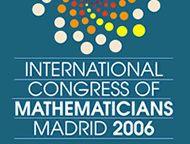Scientific Sections
1. Logic and Foundations
Model theory. Set theory and general topology. Recursion. Logics. Proof theory. Applications.
2. Algebra
Finite groups and their representations. Infinite and topological groups (except as specified in 7). Combinatorial group theory. Rings, algebras and modules (except as specified in 7). Algebraic K-theory. Category theory and homological algebra. Computational algebra.
3. Number Theory
Analytic number theory. Algebraic number theory. Local and global fields, their Galois groups and representations of these groups. Zeta and L-functions and their special values. Diophantine equations. Arithmetic on algebraic varieties. Diophantine approximation, transcendental number theory and geometry of numbers. Arakelov theory. Modular forms and curves. p-adic analysis. p-adic representations of p-adic groups.
Computational number theory.
4. Algebraic and Complex Geometry
Algebraic varieties, their cycles, cohomologies and motives (including positive characteristics). Schemes. Commutative algebra. Low dimensional varieties. Singularities and classification. Birational geometry. Moduli spaces. Abelian varieties and p-divisible groups. Sheaves. Transcendental methods, topology of algebraic varieties. Complex differential geometry, Kahler manifolds and Hodge theory. Relations with mathematical physics and representation theory. Real algebraic and analytic sets. Rigid and p-adic analytic spaces. Non-commutative algebraic geometry.
5. Geometry
Local and global differential geometry. Applications of PDE to geometric problems including harmonic maps, minimal submanifolds and flows on the space of metrics. Geometric structures on manifolds. Riemannian and metric geometry. Geometric aspects of group theory. Symplectic and contact manifolds. Convex geometry. Discrete geometry. Geometric rigidity.
6. Topology
Algebraic, differential and geometric topology. 4-manifolds including connections with gauge theory. 3-manifolds including knot theory and connections with Kleinian groups and Teichmuller theory. Topological quantum field theories.
7. Lie Groups and Lie Algebras
Algebraic and arithmetic groups. Structure, geometry and representations of Lie groups (including real, p-adic and finite of Lie type) and Lie algebras including infinite dimensional ones. Related geometric and algebraic objects, e.g. symmetric spaces, buildings, vertex operator algebras, Coxeter groups, quantum groups. Non-commutative harmonic analysis. Geometric methods in representation theory. Automorphic forms over global fields, including Langlands program. Shimura varieties. Discrete subgroups of lie groups. Lie groups and dynamics, including applications to number theory.
8. Analysis
Classical analysis, harmonic analysis (including wavelets and computational aspects), complex analysis in one and several variables, potential theory, geometric function theory (including quasi-conformal mappings), geometric measure theory.
9. Operator Algebras and Functional Analysis
Non-commutative geometry, random matrices and free probability, K-theory of C*-algebras, structure of factors and their automorphism groups, subfactors, operator-algebraic aspects of quantum field theory, linear and non-linear functional analysis, geometry of Banach spaces, asymptotic geometric analysis.
10. Ordinary Differential Equations and Dynamical Systems
Topological and formal dynamics. Geometric and qualitative theory of ODE and smooth dynamical systems, bifurcations and singularities. Hamiltonian systems and dynamical systems of geometric origin, e.g. geodesic flows. One-dimensional and holomorphic dynamics. Billiards including rational billiards. Multidimensional actions and rigidity in dynamics. Ergodic theory including applications to combinatorics and combinatorial number theory.
11. Partial Differential Equations
Solvability, regularity and stability of linear and non-linear equations and systems. Qualitative properties (singularities, symmetry, asymptotics, long time behaviour). Spectral theory, scattering, inverse problems. Variational methods and calculus of variations. Homogenization and multiscale problems. Relations to continuous media and control.
12. Mathematical Physics
Quantum mechanics. Quantum field theory. General relativity. Statistical mechanics and random media. Integrable systems. Electromagnetism. String Theory, condensed matter.
13. Probability and Statistics
Classical probability theory, limit theorems and large deviations. Combinatorial probability and stochastic geometry. Stochastic analysis. Random fields and multicomponent systems. Statistical inference, sequential methods and spatial statistics. Applications.
14. Combinatorics
Combinatorial structures. Enumeration: exact and asymptotic. Graph theory. Probabilistic and extremal combinatorics. Designs and finite geometries. Relations with linear algebra, representation theory and commutative algebra. Topological and analytical techniques in combinatorics. Combinatorial geometry. Combinatorial number theory. Matroids. Polyhedral combinatorics and combinatorial optimization.
15. Mathematical Aspects of Computer Science
Complexity theory and efficient algorithms. Randomized, distributed, online and approximation algorithms. Formal languages, computational learning and mathematical machines. Cryptography. Semantics and verification of programs. Symbolic computation. Quantum computing. Computational geometry, bioinformatics, computer vision.
16. Numerical Analysis and Scientific Computing
Design of numerical algorithms and analysis of their accuracy, stability, and complexity. Numerical solution of algebraic, differential, and integral equations. Approximation theory. Mathematical aspects of scientific computation.
17. Control Theory and Optimization
Minimization problems. Controllability, observability, stability. Robotics. Stochastic systems and control. Optimal control. Optimal design. Linear, non-linear and integer programming. Applications.
18. Applications of Mathematics in the Sciences
Mathematics applied to the physical sciences, life sciences, social sciences, and technology. Mathematics in interdisciplinary research. The interplay of mathematical modeling and mathematical analysis and its impact on the understanding of scientific phenomena.
19. Mathematics Education and Popularization of Mathematics
All aspects of mathematics education, from elementary school to higher education. Mathematical literacy and popularization of mathematics.
20. History of Mathematics
Historical studies of all of the mathematical sciences in all periods and cultural settings.

